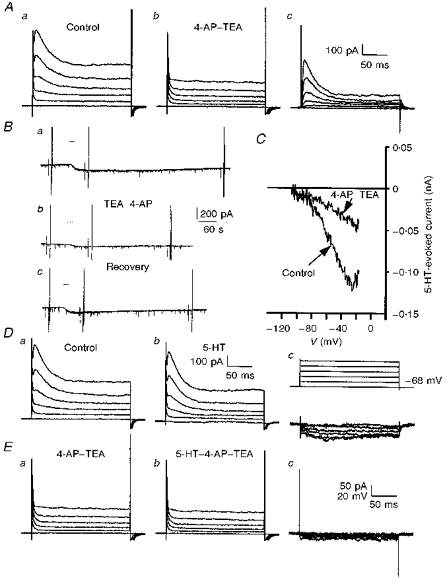Figure 10. Actions of 4-AP on I5-HT.

A, superimposed whole-cell current records obtained using depolarizing voltage steps shown in Dc (upper traces) prior to (a), and during (b), application of 4-AP (4 mm) with TEA (30 mm). Subtraction of the records in a and b gave the 4-AP-TEA-sensitive current (c). Note the block of both a transient and sustained outward component of current by 4-AP–TEA. Holding current was −111 pA before and −132 pA during 4-AP–TEA application. B, chart records showing the effects of bath application of 5-HT (10 μm, 10 s, horizontal bar, 8 min intervals) before (a), during (b) and after (c) application of 4-AP–TEA. 5-HT evoked a control inward current of −74 pA which was reduced to −32 pA in 4-AP–TEA and recovered to −84 pA after washout of the channel blockers. Holding current was −46, −98 and −54 pA in a, b and c, respectively. C, superimposed plots of I5-HT in the absence and presence of 4-AP–TEA taken from the same records as in B. Control is an average of I5-HT derived from Ba and c. D, whole-cell current records obtained as described in A, in the absence (a) and presence (b) of 5-HT (10 μm). Dc, 5-HT-evoked current (lower traces) obtained by subtraction of the records in a and b. Note the lack of a transient component to the 5-HT-evoked current even at potentials at which the transient outward current was activated. E, whole-cell current records obtained in the presence of 4-AP–TEA before (a) and during (b) application of 5-HT (10 μm). Ec shows that the subtracted 5-HT-evoked currents were greatly reduced in the presence of 4-AP. All recordings were obtained from the same 9-day-old facial motoneurone in 3 mm K+ ACSF, voltage clamped at −68 mV in A, D and E, and at −58 mV in B and C.
